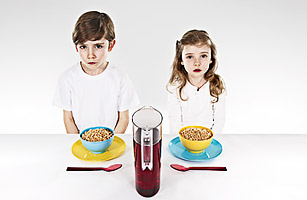
Young children are subjected to plastics in their every day life such as eating utensils, plates, bowls that might contain dangerous toxins.
On the first Earth Day, celebrated 40 years ago this month, the U.S. was a poisoned nation. Dense air pollution blanketed cities like Los Angeles, where smog alerts were a fact of life. Dangerous pesticides like DDT were still in use, and water pollution was rampant — symbolized by raging fires on Cleveland's Cuyahoga River, captured in a famous 1969 story for TIME. But the green movement that was energized by Earth Day — and the landmark federal actions that followed it — changed much of that. Today air pollution is down significantly in most urban areas, the water is cleaner, and even the Cuyahoga is home to fish again. Though climate change looms as a long-term threat, the 40th anniversary of Earth Day will see a much cleaner country.
But if the land is healing, Americans may be sickening. Since World War II, production of industrial chemicals has risen rapidly, and the U.S. generates or imports some 42 billion lb. (19 billion kg) of them per day, leaving Americans awash in a sea of synthetics. These aren't the sorts of chemicals that come to mind when we picture pollution — huge plants spilling contaminated wastewater into rivers. Rather, they're the molecules that make good on the old "better living through chemistry" promise, appearing in items like unbreakable baby bottles and big-screen TVs. Those chemicals have a habit of finding their way out of everyday products and into the environment — and ultimately into living organisms. A recent biomonitoring survey by the Centers for Disease Control and Prevention (CDC) found traces of 212 environmental chemicals in Americans — including toxic metals like arsenic and cadmium, pesticides, flame retardants and even perchlorate, an ingredient in rocket fuel. "It's not the environment that's contaminated so much," says Dr. Bruce Lanphear, director of the Cincinnati Children's Environmental Health Center. "It's us."
As scientists get better at detecting the chemicals in our bodies, they're discovering that even tiny quantities of toxins can have a potentially serious impact on our health — and our children's future. Chemicals like bisphenol A (BPA) and phthalates — key ingredients in modern plastics — may disrupt the delicate endocrine system, leading to developmental problems. A host of modern ills that have been rising unchecked for a generation — obesity, diabetes, autism, attention-deficit/hyperactivity disorder — could have chemical connections. "We don't give environmental exposure the attention it deserves," says Dr. Philip Landrigan, director of the Children's Environmental Health Center at New York City's Mount Sinai Medical Center. "But there's an emerging understanding that kids are uniquely susceptible to environmental hazards."
If scientists were slow to arrive at that conclusion, Washington has been even slower. The Toxic Substances Control Act (TSCA), the 34-year-old vehicle for federal chemical regulation, has generally been a failure. The burden of proving chemicals dangerous falls almost entirely on the government, while industry confidentiality privileges built into the TSCA deny citizens and federal regulators critical information about how substances are made and what their effects are. In the years since the TSCA became law, the Environmental Protection Agency (EPA) has been able to issue restrictions on only a handful of chemicals and has lacked the power to ban even a dangerous carcinogen like asbestos.
But change is coming. The Obama Administration is taking a closer look at chemicals, with the EPA late last month launching a new investigation into BPA. More important, Congress may finally be ready to act. New Jersey Senator Frank Lautenberg is expected to draft legislation soon that would give the TSCA the teeth it needs. "It's obvious that the system doesn't work," says Lautenberg. "We can't permit this assault on our children's health — and our own health — to continue."
The Low-Dose Threat
His name was Theophrastus Philippus Aureolus Bombastus von Hohenheim, known to his contemporaries as Paracelsus and to students of science as the "father of toxicology." The 16th century Swiss physician pioneered the use of chemicals in medicine. His dictum "The dose makes the poison" — that even toxic substances can be safe as long as the amount remains below a certain threshold — is still a bedrock principle for modern toxicologists.